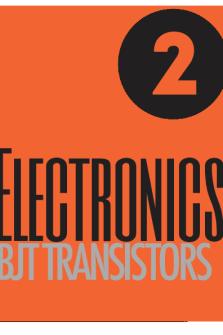Lab Report 3. NPN and PNP Transistors, Transistors Biasing, Q point stabilization PDF

| Title | Lab Report 3. NPN and PNP Transistors, Transistors Biasing, Q point stabilization |
|---|---|
| Pages | 6 |
| File Size | 819.9 KB |
| File Type | |
| Total Downloads | 53 |
| Total Views | 141 |
Summary
School of Engineering Department of Electrical and Electronic Engineering Analog Electronics Lab Report 3 Student Name: Sanzhar Askaruly Name of Lecturer: Alexander Ruderman Personal Tutor: Nazim Mir-Nasiri Astana, 2014 Introduction This lab session has a purpose of practical implementation of theor...
Description
School of Engineering Department of Electrical and Electronic Engineering
Analog Electronics Lab Report 3
Student Name: Sanzhar Askaruly Name of Lecturer: Alexander Ruderman Personal Tutor: Nazim Mir-Nasiri
Astana, 2014
Introduction This lab session has a purpose of practical implementation of theoretical knowledge about transistors. There are four parts in the work:
NPN and PNP Transistors Transistors Biasing Q point stabilization
Apparatus The following equipment was used during the lab:
MCM3/EV board Power supply PSLC or PS1-PSU/EV Accessories
As in the previous lab, the whole lab work is done with the MCM/EV board. The oscilloscope was used for the visualization of the waveforms. Screwdriver was used for the variable resistor configuration.
Work process 5. NPN and PNP Transistors Using jumpers the circuit shown in figure 1 was built.
Figure 1. Transistor circuit Base Current, IB (µA)
Collector Current, IC (mA)
20 40 60 80 100
8 13 19 25 27
hFE hFE = Ic/Ib 400 325 317 313 270
Q1. What range does hFE lie in? d) 100-400
Collector Current, Ic (mA)
Collector Current over Base Current 26 23 20 17 14 11 8 20
40
60
80
100
Base Current, Ib, (µA)
As it can be seen from the graph, collector current steadily increases with the increase in base current. Only when the base current exceeds 80 µA, the coefficient hFE starts to decrease. 6. Transistors Biasing Next, with the help of jumpers the circuit shown in figure 2 was built.
Figure 2. Transistor Biasing Circuit
𝐼𝑐𝑠𝑎𝑡 =
𝑉𝐶𝐶 − 𝑉𝐶𝐸𝑄 20 − 0 = = 42.68 𝑚𝐴 𝑅2 468.6 𝑚𝐴
The cut-off voltage was determined to be VCEM = 19.99 V Q2. What is the voltage VCE in saturation condition? e) 0.2 V
7. Q Point Stabilization 7.1. Stabilization circuit with RE Further, the circuit shown in figure 3 was built.
Figure 3. Stabilization circuit with RE Initially, VBE = 622 mV, IC = 11 mA and VO was found to be 598 mV. During the experiment, we tried to increase the temperature by connecting power to the heating resistor. As a result, transistor T5 was heated. As we noted, the following was observed: Q3. When the temperature increases what happens to this voltage and current? d) the current increases and the voltage drops After the, heating resistor was removed. Connecting J11 jumper, we measured IB current using ammeter. Collector current stays constant. As a result, IC = 10 mA and IB = 26 µA. Therefore, current gain was calculated: ℎ𝐹𝐸 =
𝐼𝐶 𝐼𝐵
= 385.
Q4. What is the calculated current gain? e) hFE > 150 Further, after disconnection of J10 and J11 jumpers, the resistance RBM was measured. The equivalent base resistance is estimated using this formula:
RBM was measured to be 32.7 kOhm. 27.6 𝑘𝑂ℎ𝑚 × [(89.4 − 27.6)𝑘𝑂ℎ𝑚 + 32.7 𝑘𝑂ℎ𝑚] 𝑅𝐵𝑀 = = 21.34 𝑘𝑂ℎ𝑚 [89.4 + 32.7]𝑘𝑂ℎ𝑚 After that stability factor is found from:
Therefore, 𝑆𝑣 = −
1 = −0.023 21.34 𝑘𝑂ℎ𝑚 385 + 100 𝑂ℎ𝑚
Q5. What is the stability factor Sv? c) between -1 and 0 7.2. Stabilization circuit with collector-base resistance
Figure 4. Stabilization circuit with collector-base resistance Initially, collector current was configured to 5mA. Q6. The variations of IC are smaller when the feedback resistor R8 is inserted. No Answer. I did not understand the meaning of question asked. I tried to simulate without R8 resistor and using R8 resistor. In both, cases the graph shows increasing pattern. However, there is discrepancy after 6V is reached by Vcc. The plot below provided below describes Vcc to Ic relation. When there is no resistor R8:
The same graph, but with feedback resistor R8 is place:...
Similar Free PDFs

Diferencia entre PNP y NPN
- 10 Pages

Uso de un transistor NPN y PNP
- 10 Pages

Melting point Lab report
- 4 Pages

Boiling Point Lab report
- 3 Pages

Lab report (melting point)
- 3 Pages

Melting Point - lab report
- 3 Pages
Popular Institutions
- Tinajero National High School - Annex
- Politeknik Caltex Riau
- Yokohama City University
- SGT University
- University of Al-Qadisiyah
- Divine Word College of Vigan
- Techniek College Rotterdam
- Universidade de Santiago
- Universiti Teknologi MARA Cawangan Johor Kampus Pasir Gudang
- Poltekkes Kemenkes Yogyakarta
- Baguio City National High School
- Colegio san marcos
- preparatoria uno
- Centro de Bachillerato Tecnológico Industrial y de Servicios No. 107
- Dalian Maritime University
- Quang Trung Secondary School
- Colegio Tecnológico en Informática
- Corporación Regional de Educación Superior
- Grupo CEDVA
- Dar Al Uloom University
- Centro de Estudios Preuniversitarios de la Universidad Nacional de Ingeniería
- 上智大学
- Aakash International School, Nuna Majara
- San Felipe Neri Catholic School
- Kang Chiao International School - New Taipei City
- Misamis Occidental National High School
- Institución Educativa Escuela Normal Juan Ladrilleros
- Kolehiyo ng Pantukan
- Batanes State College
- Instituto Continental
- Sekolah Menengah Kejuruan Kesehatan Kaltara (Tarakan)
- Colegio de La Inmaculada Concepcion - Cebu









